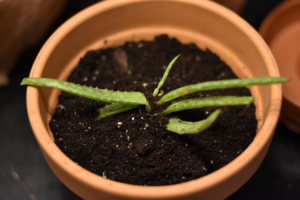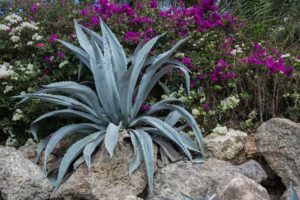My darling, Mr Green Thumb, can grow anything. He’s much like how his dad was – he can take something that was almost dead and spring it back to life. I, on the other hand, am Mrs. Brown Thumb. I kill stuff. Growing plants is just not my thing. I’ve tried before and failed miserably…except!
Aloe.

I LOVE the Aloe Vera plant. Mainly because I can completely forget about it and it not only survives, but thrives. Seriously, it is the only thing in my house that I can completely ignore and it prefers it that way. Imagine that! The more I neglect it the more it loves me. We’re a match made in heaven. I started off with one plant and now I have four. I had five, but I gave one to my sister who is also a serial plant killer. I think the plant I gave her will be happy there LOL.
So, what about this Aloe Vera plant? Some of you may be like me, a “Brown Thumb”, but really want the joy of growing a plant. I suggest you should start with this. Aloe is not only easy to care for, but it’s pretty to look at and it’s useful. Here are a few facts, uses, and care tips for this miracle plant.
Aloe Vera is native to the continent of Africa. In fact, it has been found scribed on ancient walls in Egypt. Because it’s from the continent of Africa, it is by nature an arid succulent. What that simply means is this, like a cactus, is a plant that holds its own moisture in its leaves because it is accustomed to dry dirt and hot, arid conditions. This is why it’s such a great plant for those who don’t do well with watering and upkeep. The only time you need to water this plant is after you touch under the top layer of soil and feel that the dirt is really dry. If the tips of the leaves are turning brown, you’ve let it go a little too long without water. Just give it some, clip off the brown tips, and it will take care of itself.
Aloe likes full sun. So, if you are in a climate that stays above 40 degrees, you can leave it outside. Anything less than that, the leaves can freeze (remember, the leaves hold water/its moisture). If you want to keep it inside, then put it in a window that will give it sun for at least six hours a day. The only thing I will caution you about is if your plant is used to being inside, don’t shock it by throwing it outside in full sun and heat. You can burn the leaves. Let it spend a few hours outside at a time lengthening the time it spends each time until you think it won’t burn or put it outside in partial shade.

Most people will keep their aloe plants in pots. I personally have taken to using terracotta clay pots for two reasons. One, because they are pretty to me. Two, you can gauge when you need to water the plant. Because the pot is clay, it wicks moisture out of the soil, which is helpful for the plant since it likes dry soil anyway. Also, you can tell both by sight and touch often times, how moist the soil is after you’ve watered the plant. Keeping the plant in a pot instead of directly planting it in the ground also helps with transporting it when needed. Others, if they live in an arid climate, will like to use aloe as a landscaping plant which is very pretty when surrounded by other succulent plants. If you choose this route, just make sure you keep your plant in well draining soil.
I guess I should quickly tell you where to find it, hunh? Aloe can be grown from seeds. I’ve personally never done it that way, but, from what I hear, it’s pretty easy. You’d first want to order seeds from a reputable company (a little research is needed here) unless you just so happen to know someone who has an aloe plant that has started flowering and putting out seeds. They are little flat, grayish brown looking seeds. If they are white, they are not ready to germinate – remember, the darker the color of the seed, the better. Then you’d want to plant those seeds in loose, well draining dirt about an inch apart and keep them warm (either outside or in) at about 75 degrees. As far as the dirt, any plant store should be able to help you pick out the kind of succulent dirt, or combination of growing medium you may need for this. Spritz the top layer of soil to keep it moist for your germinating plants. Be careful not to cover unless you are sure your soil won’t grow fungus. Your growing process will take anywhere from two to about four weeks. When you see about four leaves sprout, it may be safe to transplant into a pot of its own.
If you don’t want to wait that long, then by all means, go to a farmer’s market, plant store, or ask a friend if their aloe plant has developed “pups”. Those are off-shoots that can be broken from the “mother” plant by uprooting it, shaking the dirt loose, carefully separating the pup, and repotting both the mother plant in its regular pot and putting the pup in its own pot. Those plants would be ready and should be strong enough to use minimally.
There are many uses for this plant, but the popular ones everyone know about are using it topically for cuts, minor burns, insect bites, rashes, or itchy skin. Some people use it as a laxative, but it is not recommended to use this way. I have never done it either. You can also use the aloe gel in lotions or as a gel for beauty treatments. One more great use is as an “air purifier”. This plant has just so many uses, you should look it up and see how you’d like to use it.
So, there you have it. For all you brown thumbs out there like me aspiring to have a plant in your home to liven up the place, but are afraid you’ll kill it, get an aloe plant. I think you’ll be happy you did!




